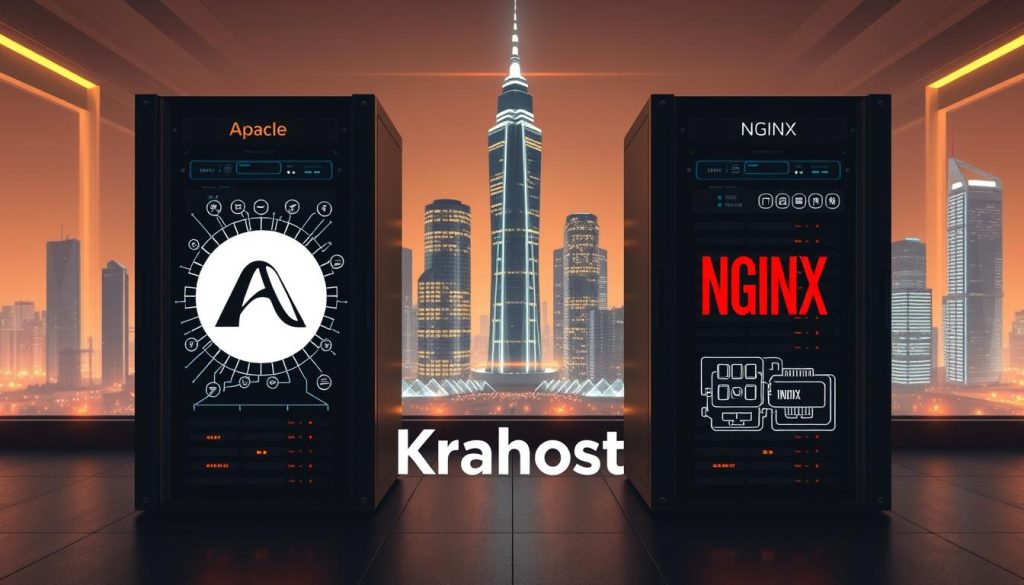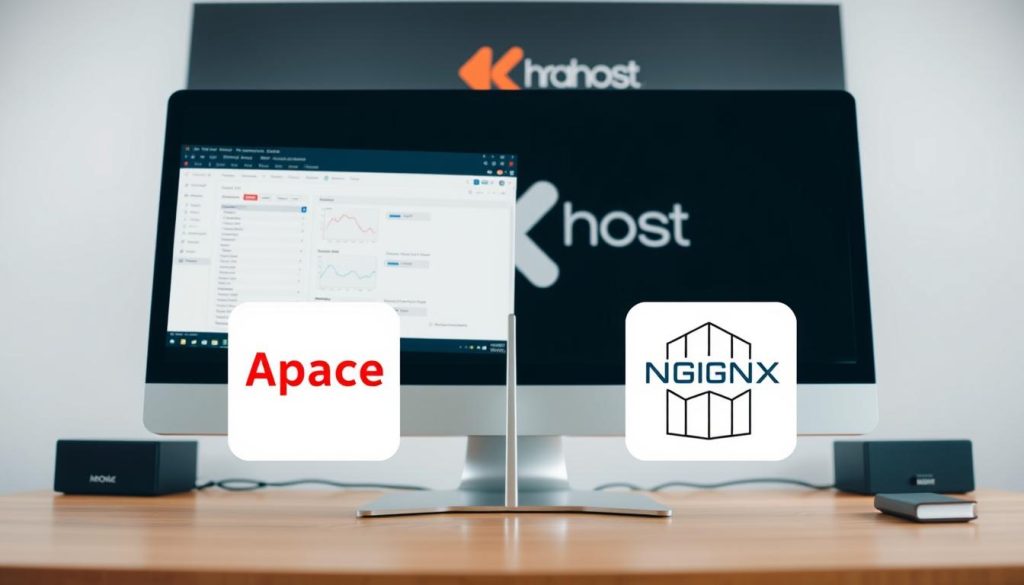
Apache vs NGINX: Comparing the Top Web Servers
Choosing a reliable web server is a big decision. Apache and NGINX are two top choices. They serve a lot of websites around the world. The right choice can affect your site’s speed, security, and how well it grows.
When picking a host, knowing what each server does well is key. Finding the best web server is a big step. Krahost.com offers great hosting and domain services, making it a top pick for your site.
Key Takeaways
- Understanding the differences between Apache and NGINX is key for picking the right web server.
- Both have their strong points and weaknesses in performance and security.
- The web server you choose can really impact your site’s growth.
- Krahost.com offers reliable hosting and domain services.
- Picking the right web server is a critical step for hosting your site well.
Understanding Web Servers
Web servers are key to your website’s performance and reach. They are software apps that share content over the internet.
What is a Web Server?
A web server hosts and manages web content for users. When you visit a website, your browser asks the server for the site’s content. Then, the server sends the content back to your browser.
The Role of Web Servers in Website Performance
Your website’s speed and performance depend on its web server. A good server can make your site load faster, handle more visitors, and improve user experience.
Why Your Web Server Choice Matters
Picking the right web server is vital for your site’s success. Deciding between Apache and NGINX affects your site’s speed, security, and growth. For the best results, consider hosting with Krahost.com, known for reliable services.
| Web Server | Key Features | Performance Impact |
|---|---|---|
| Apache | Modular architecture, .htaccess support | High resource usage with many requests |
| NGINX | Event-driven architecture, reverse proxy | High performance with low resource usage |
Apache and NGINX: A Brief History
Knowing where Apache and NGINX come from helps us see what they can do today. Their histories have shaped how they work and why people choose them.
The Origin of Apache HTTP Server
The Apache HTTP Server, or just Apache, started in 1995 by the Apache Software Foundation. It grew from the NCSA HTTPd server. Now, it’s a top web server on the internet.
Apache is loved for its flexibility, growth, and many modules. This makes it very popular.
The Development of NGINX
NGINX, or “engine-x,” was made by Igor Sysoev and came out in 2004. It was made to solve the C10k problem (handling 10,000 connections at once). NGINX is lighter and more efficient than old web servers like Apache.
Its design makes it great for big traffic and lots of connections.
Market Share and Adoption Trends
Apache and NGINX both have big parts of the market. Apache used to be the top, but NGINX is catching up. NGINX is now a favorite for big sites because it’s fast and good at handling lots of requests.
The stories of Apache and NGINX show their strengths. Knowing these helps us pick the right web server.
Architecture Differences Between Apache and NGINX
The way Apache and NGINX work is key to understanding their strengths. These differences affect how they handle requests and manage resources. This, in turn, impacts the user experience.
Apache’s Process-Driven Approach
Apache uses a process-driven method. Each request gets its own process or thread. This can use more memory and might slow down under heavy traffic. Yet, Apache’s design is modular, making it easy to customize with various modules.
Key Characteristics of Apache’s Architecture:
- Process-based model
- Highly modular and customizable
- Can be resource-intensive
NGINX’s Event-Driven Architecture
NGINX, on the other hand, has an event-driven architecture. It’s great at handling lots of connections at once. NGINX uses a single thread and non-blocking I/O. This makes it scalable and efficient, using fewer resources.
Key Characteristics of NGINX’s Architecture:
- Event-driven, non-blocking I/O
- Highly scalable and efficient
- Low resource consumption
Impact on Server Performance
The architecture of Apache and NGINX affects their performance. NGINX is better for sites with lots of traffic because it handles connections well. Apache can also perform well, but it might need more tweaking to match NGINX’s speed.
Here’s a comparison of Apache and NGINX’s architectural features:
| Feature | Apache | NGINX |
|---|---|---|
| Architecture | Process-driven | Event-driven |
| Concurrency Handling | Resource-intensive | Efficient, non-blocking |
| Scalability | Limited by resources | Highly scalable |

Performance Comparison: Apache vs NGINX
Knowing how Apache and NGINX perform is key to making your website better. When picking a web server, how well it works is very important. It affects how users see your site and how search engines rank it.
Static Content Handling
Apache and NGINX serve static content in different ways. NGINX is great at this because it’s designed to handle lots of connections at once. This means it uses less resources. Apache, on the other hand, uses more resources when it gets a lot of requests.
Dynamic Content Processing
Apache is often chosen for dynamic content because it supports PHP well. But NGINX is catching up. It can handle dynamic content efficiently with FastCGI and other protocols.
Concurrency and Resource Utilization
NGINX is better at handling lots of connections at once. This is because it’s designed to work asynchronously. This makes NGINX use resources better than Apache, which works synchronously.
Real-World Benchmarks
Real-world tests often show NGINX doing better than Apache, mainly with static content and lots of connections. But, the actual difference can depend on many things like server setup and content type.
| Feature | Apache | NGINX |
|---|---|---|
| Static Content Handling | Good | Excellent |
| Dynamic Content Processing | Excellent | Very Good |
| Concurrency | Fair | Excellent |
| Resource Utilization | High | Low |
In Ghana, knowing these differences is important for businesses. Krahost.com provides hosting that helps you use your web server to its fullest, whether it’s Apache or NGINX.
Configuration and Ease of Use
Choosing between Apache and NGINX depends on how easy they are to set up. Knowing how to configure each and the support they offer is key.
Apache Configuration Basics
Apache’s setup is mainly done through the httpd.conf file. This file lets you tweak server settings, like virtual hosts and security. Apache’s design lets you pick which modules to use, making it flexible.
NGINX Configuration Approach
NGINX has a simpler setup and is great for serving static content. Its config files are easy to understand, focusing on simplicity. Many find NGINX easier to use, thanks to its Unix-like system familiarity.
Learning Curve Comparison
Apache’s learning curve is steeper because of its many features. But, for those who know Apache, it’s not too hard. NGINX is easier to learn, perfect for beginners, with its simple setup.
Documentation and Community Support
Both Apache and NGINX have lots of help and communities. Apache, being older, has a wealth of resources. NGINX also has great docs and a growing community.
A NGINX developer said, “NGINX is designed to be highly performant and easy to configure, making it an excellent choice for modern web applications.” Many users agree, praising NGINX for its simplicity and speed.
When picking between Apache and NGINX, think about what you need and your skill level. Apache is good for those who want lots of customization and are okay with a complex setup. NGINX is ideal for a simple, fast solution.
Security Features in Apache and NGINX
When choosing between Apache and NGINX for your web server, knowing their security features is key. Both are known for their strong security, but they handle it differently.
Built-in Security Mechanisms
Apache and NGINX both have built-in security tools. Apache uses mod_auth and mod_ssl for secure login and data encryption. NGINX also supports SSL/TLS encryption and has modules for controlling access.
Module-Based Security Extensions
Both servers can add extra security through modules. Apache’s design lets you add many security modules, like mod_security for a strong Web Application Firewall (WAF). NGINX also has a WAF module and other security tools.
Security Best Practices for Both Servers
It’s important to follow security best practices, no matter your server choice. This means keeping everything updated, using strong passwords, and limiting access. For example, fail2ban can help block brute-force attacks on both servers.
Vulnerability Management
Keeping your server and modules up to date is vital for security. Both Apache and NGINX have active communities that fix security issues. Staying on top of these updates and applying them quickly is essential for a secure server.
In summary, both Apache and NGINX have strong security features to protect your site. By using their built-in tools, adding modules, following best practices, and managing vulnerabilities, you can greatly improve your site’s security.
Apache and NGINX: Impact on SEO Performance
Knowing how Apache and NGINX affect SEO is key for better search rankings. The web server you pick can change how your site shows up on search engines.
Server Response Time and SEO Rankings
Server response time is very important for SEO. A quicker server can make your site better for users and search engines. NGINX is great at handling lots of users at once, which might make it faster than Apache in busy times.
Mobile Optimization Capabilities
Mobile-first indexing is getting more important. Your web server needs to handle mobile well. Both Apache and NGINX can serve mobile content well. But, NGINX is easier to set up for mobile.
HTTPS Implementation and SEO Benefits
HTTPS is good for search rankings, and both servers support it. Apache has strong SSL/TLS support, and NGINX does it natively. Good HTTPS setup can boost your site’s security and SEO.
Which Server is Better for SEO?
Both servers can be good for SEO, but your choice depends on your site’s needs. NGINX might be better for busy sites. For the best SEO, test different setups based on your site’s needs.
For top hosting and domain services that support SEO, check out Krahost.com. They provide reliable solutions for better website performance.
How to Choose Between Apache and NGINX for Your Website
Choosing between Apache and NGINX depends on your website’s needs. Both have their own strengths and weaknesses. Knowing these differences is key to making the right choice.
Website Type and Traffic Considerations
NGINX is great for high-traffic sites or those with static content. Its event-driven design handles many requests at once well. Apache, on the other hand, is better for complex setups or dynamic content sites.
Technical Expertise Requirements
If your team knows .htaccess files and Apache setup, sticking with Apache might be easier. But, NGINX’s simpler setup might appeal to those who value ease of use.
Budget and Resource Constraints
Both Apache and NGINX are free and open-source. But, remember to consider costs for support, upkeep, and hardware upgrades. Here’s a comparison:
| Web Server | Initial Cost | Maintenance Cost | Scalability Cost |
|---|---|---|---|
| Apache | Free | Variable | Variable |
| NGINX | Free | Variable | Variable |
Specific Needs for Ghanaian Websites
For Ghanaian sites, think about local content, laws, and language support.
Choosing between Apache and NGINX should be based on your site’s needs, your team’s skills, and your budget.
Step-by-Step Guide to Setting Up Apache and NGINX
We’ll show you how to install and set up Apache and NGINX. Both are great for managing your website’s traffic. But, they need different steps to get them running well.
Installing and Configuring Apache
Apache is a top web server known for its flexibility and many modules.
Basic Installation Steps
To install Apache on Linux, use the package manager. For example, on Ubuntu, you can run:
sudo apt-get update sudo apt-get install apache2
After installing, check if Apache is working by going to http://localhost in your browser.
Essential Configuration Options
Apache’s settings are mainly in the apache2.conf file. Important options include:
- ServerRoot: The directory where the server is installed.
- DocumentRoot: The main document tree visible from the web.
- DirectoryIndex: The files to serve when a directory is requested.
Performance Tuning Tips
To make Apache faster, consider these tips:
- Enable mod_deflate for compression.
- Adjust the MaxClients directive to handle more connections.
- Use a caching mechanism like mod_cache.
Installing and Configuring NGINX
NGINX is known for its high performance, scalability, and low resource use.
Basic Installation Steps
To install NGINX, use the package manager. On Ubuntu, the commands are:
sudo apt-get update sudo apt-get install nginx
Check if NGINX is running by visiting http://localhost in your browser.
Essential Configuration Options
NGINX’s main file is nginx.conf. Important settings include:
- worker_processes: The number of worker processes to run.
- server_name: Specifies the server name and port.
- location: Defines how to handle different URI requests.
Performance Tuning Tips
For the best NGINX performance:
- Adjust the worker_connections to increase connections.
- Enable gzip compression to reduce file sizes.
- Use caching to lessen server load.
Here’s a comparison of some key configuration options for Apache and NGINX:
| Feature | Apache | NGINX |
|---|---|---|
| Configuration File | apache2.conf | nginx.conf |
| Performance Tuning | MaxClients, mod_deflate | worker_connections, gzip |
| Modules | Extensive module ecosystem | Modules are built-in or dynamically loaded |

Optimizing Your Web Hosting with Krahost.com
Getting your website to run smoothly starts with the right web hosting. Krahost.com is great at hosting both Apache and NGINX servers. They focus on quality services to meet your web server needs.
Krahost.com’s Apache and NGINX Hosting Solutions
Krahost.com has strong hosting options for both Apache and NGINX servers. Their plans are made for different business needs. They offer flexibility and can grow with your business.
Domain Registration and Management Services
Krahost.com also helps with domain registration and management. This makes them a complete solution for your online presence.
| Service | Apache Hosting | NGINX Hosting |
|---|---|---|
| Server Performance | Optimized for high traffic | Event-driven architecture |
| Technical Support | 24/7 Expert Assistance | 24/7 Expert Assistance |
Technical Support for Web Server Configuration
Krahost.com’s tech support team is ready 24/7. They help with web server setup to keep your site running well.
Special Hosting Packages for Ghanaian Businesses
Krahost.com has special hosting plans for Ghanaian businesses. They offer a solution that fits the local market.
Conclusion: Making the Right Web Server Choice for Your Needs
Choosing between Apache and NGINX is a big decision. It affects your website’s performance, security, and how it grows. We’ve looked at what each offers, from their setup to their safety and SEO benefits.
Think about what you need for your website. This includes the type of site, how many visitors you expect, and your technical skills. For businesses in Ghana, Krahost.com provides hosting, including Apache and NGINX. They also help with domain names and offer support to make your site a success.
Knowing what each web server can do helps you make a smart choice. Whether you pick Apache or NGINX, make sure your hosting company supports you well. For top hosting and domain services, visit Krahost.com and boost your online presence.